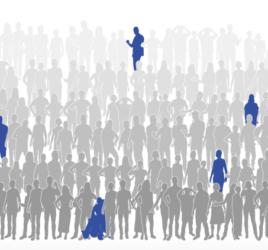In her book, Thinking in Systems, pioneer in systems thinking Donella Meadows aimed to give readers “a basic ability to understand and to deal with complex systems” (Meadows & Wright, 2008, p. x). Due to the author’s untimely death in 2001, the work was edited and published at a later time. It was the hope of the editor “to increase the ability of readers to understand and talk about the systems around them and to act for positive change” (Meadows & Wright, 2008, p. xiii). The book is divided into three parts, with part one giving a basic introduction to systems; part two going into depth of why systems work, why they sometimes surprise us, and how system traps can be turned into opportunities; and part three showing how and where to intervene in systems to create change.
The simple stock-flow chart presented by Meadows reminded me of a very similar chart I had drawn about 10 years ago. I was trying to identify the process of our church, Hanoi International Fellowship (HIF). During HIF’s first decade from 1995-2005, our focus was primarily on providing services for the inflow of expatriates who were already Christian when arriving in Hanoi. The outflow simply was these same people leaving, except that they had become HIFers in the process (see Figure 1).

Figure 1: HIF process in first decade
This all changed in 2005 when HIF went through the missional paradigm shift. Rather than seeing people as just coming and going, it became our vision to disciple, equip and send them. (see Figure 2).

Figure 2: HIF process in second decade
For the third decade, our vision has become much bigger than ourselves as we seek to bring transformation to the city of Hanoi. Though the following diagram might seem oversimplified, Meadows & Wright remind us that, “…all system diagrams are simplifications of the real world” (2008, p. 28, italics original). Systems thinking to the most fundamental level of stock-flow forces us to focus on the exact purpose of why we are doing what we are doing.

Figure 3: HIF process to love Hanoi in third decade
Meadows & Wright point out that “paradigms are harder to change than anything else about a system” (2008, p. 163), yet it can happen with “a click in the mind, a falling of scales from the eyes, a new way of seeing” (2008, p. 164). To the question how paradigm shifts change, Meadow & Wright state,
You keep pointing at the anomalies and failures in the old paradigm. You keep speaking and acting, loudly and with assurance, from the new one. You insert people with the new paradigm in places of public visibility and power. You don’t waste time with reactionaries; rather you work with active change agents and with the vast middle ground of people who are open-minded. (2008, p. 164)
Currently, God is bringing about a paradigm shift among evangelical church leaders and the city government leaders in Hanoi. They are seeing in a new way that Christians can be a positive contributor and collaborator towards the peace of the city. One example that speaks loudly are the rehabilitation ministries among drug addicts. The new paradigm of Christian rehab has significantly greater success than the old government systems. One of these ministries has become quite visible, with national TV channels broadcasting the news of their success. Working alongside these change agents, it is my hope to lend a hand in this paradigm shift and that soon the “click in the mind” will take place.
By Jacob Bloemberg
Meadows, D. H., & Wright, D. (2008). Thinking in systems : a primer. White River Junction, Vt.: Chelsea Green Pub.




